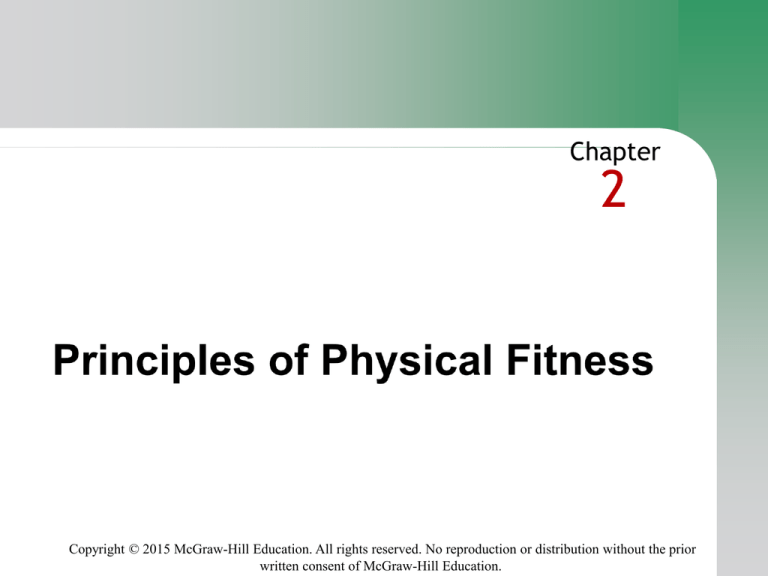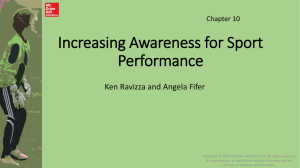
Chapter
2
Copyright © 2015 McGraw-Hill Education. All rights reserved. No reproduction or distribution without the prior
written consent of McGraw-Hill Education.
Physical Activity and Exercise for Health and Fitness
Components of Physical Fitness
Principles of Physical Training: Adaptation to Stress
Designing Your Own Exercise Program
Copyright © 2015 McGraw-Hill Education. All rights reserved. No reproduction or distribution without the prior
written consent of McGraw-Hill Education.
2-2
Almost any kind of physical
activity promotes health
Short periods of intense exercise do
not compensate for hours of inactivity
Copyright © 2015 McGraw-Hill Education. All rights reserved. No reproduction or distribution without the prior
written consent of McGraw-Hill Education.
2-3
SOURCE: Adapted from a composite of 12 studies
involving more than 200,000 men and women. Wen,
M., et al. 2013. Physical activity and mortality among
middle-aged and older adults in the United States.
Journal Physical Activity & Health. Published online;
Physical Activity Guidelines Advisory Committee
Physical Activity Guidelines Advisory Committee
Report, 2008. Washington, D.C.: U.S. Department of
Health and Human Services, 2008.
Copyright © 2015 McGraw-Hill Education. All rights reserved. No reproduction or distribution without the prior
written consent of McGraw-Hill Education.
2-4
Physical activity:
Body movement carried out by skeletal
muscles that requires energy
Exercise:
Planned, structured, repetitive
movement intended to improve or
maintain physical fitness
Physical activity essential to health,
but exercise necessary to improve fitness
Copyright © 2015 McGraw-Hill Education. All rights reserved. No reproduction or distribution without the prior
written consent of McGraw-Hill Education.
2-5
Increasing physical activity to improve
health and wellness
Healthy adults should perform
150 minutes of moderate intensity
aerobic exercise or at least 75 minutes
of vigorous intensity exercise per week
▪ Increasing volume and intensity
results in additional health benefits
Copyright © 2015 McGraw-Hill Education. All rights reserved. No reproduction or distribution without the prior
written consent of McGraw-Hill Education.
2-6
Increasing Physical Activity
Moderate to high intensity
resistive exercises promote
strength and endurance
Avoid inactivity
Copyright © 2015 McGraw-Hill Education. All rights reserved. No reproduction or distribution without the prior
written consent of McGraw-Hill Education.
2-7
SOURCE: National Heart, Lung, and Blood
Institute. 2010. Why Is Exercise Important?
(www.nhlbi.nih.gov/health/public/heart/obesit
y/loewt/physical/htm; retrieved July 30, 2013)
Copyright © 2015 McGraw-Hill Education. All rights reserved. No reproduction or distribution without the prior
written consent of McGraw-Hill Education.
2-8
Increasing physical
activity to manage weight
66% of Americans carry extra weight
U.S. Department of
Health and Human Services:
▪ 150 minutes per week of physical
activity may not be enough to lose weight
▪ Recommend up to 90 minutes
of physical activity per day
Copyright © 2015 McGraw-Hill Education. All rights reserved. No reproduction or distribution without the prior
written consent of McGraw-Hill Education.
2-9
Exercising to improve physical fitness
People can obtain greater health and
wellness benefits by increasing the
duration and intensity of physical activity
Copyright © 2015 McGraw-Hill Education. All rights reserved. No reproduction or distribution without the prior
written consent of McGraw-Hill Education.
2-10
Copyright © 2015 McGraw-Hill Education. All rights reserved. No reproduction or distribution without the prior
written consent of McGraw-Hill Education.
2-11
Regular physical activity promotes
health and protects from chronic
diseases
Need physical
energy and stamina
Any increase
improves health
and well-being
Copyright © 2015 McGraw-Hill Education. All rights reserved. No reproduction or distribution without the prior
written consent of McGraw-Hill Education.
2-12
Health-related fitness: Physical
capacities that contribute to health
Cardiorespiratory endurance:
Ability of the body to perform
prolonged, large-muscle, dynamic
exercise at moderate-to-high intensity;
central component of
health-related fitness
Copyright © 2015 McGraw-Hill Education. All rights reserved. No reproduction or distribution without the prior
written consent of McGraw-Hill Education.
2-13
Muscular strength: force a muscle
produces with single maximum effort
Metabolism: Sum of the vital processes
by which food energy and nutrients are
made available to and used by the body
▪ Greater muscle mass means
higher rate of metabolism
Muscular endurance: Ability of muscle
to remain contracted or to contract
repeatedly for a long period of time
Copyright © 2015 McGraw-Hill Education. All rights reserved. No reproduction or distribution without the prior
written consent of McGraw-Hill Education.
2-14
Flexibility: ability
to move joints
through their full
ranges of motion
Fat-free mass: Nonfat
component of human
body, consisting
of skeletal muscle,
bone, and water
Copyright © 2015 McGraw-Hill Education. All rights reserved. No reproduction or distribution without the prior
written consent of McGraw-Hill Education.
2-15
Body composition: Proportion
of fat and fat-free mass (muscle,
bone, and water) in a body
Somatotype: body-type
classification system that
describes people as
predominantly muscular
(mesomorph), tall and
thin (ectomorph), or
round and heavy (endomorph)
Copyright © 2015 McGraw-Hill Education. All rights reserved. No reproduction or distribution without the prior
written consent of McGraw-Hill Education.
2-16
Skill-related fitness: Complex
control of muscles and movement
by the brain and spinal column;
components include speed,
power, agility, balance,
coordination, and reaction time
Copyright © 2015 McGraw-Hill Education. All rights reserved. No reproduction or distribution without the prior
written consent of McGraw-Hill Education.
2-17
The human body is adaptable and
adjusts to meet increasing demands
Short term adjustments lead
to long-term changes and
improvements in fitness levels
Physical training: Performance of
different types of activities to produce
long-term changes and improvements in
the body’s functioning and fitness
Copyright © 2015 McGraw-Hill Education. All rights reserved. No reproduction or distribution without the prior
written consent of McGraw-Hill Education.
2-18
Specificity: Training principle
that states that to develop a particular
fitness component, one must
perform exercises designed
specifically for that component
Well-rounded exercise program
should include exercises geared
to each component of fitness
Copyright © 2015 McGraw-Hill Education. All rights reserved. No reproduction or distribution without the prior
written consent of McGraw-Hill Education.
2-19
Progressive overload: Training
principle that states that placing
increasing amounts of stress on the
body causes adaptations that improve
fitness
As amount of exercise progressively
increases, fitness improves
Copyright © 2015 McGraw-Hill Education. All rights reserved. No reproduction or distribution without the prior
written consent of McGraw-Hill Education.
2-20
FITT:
Frequency
Intensity
Time (duration)
Type (mode of activity)
Copyright © 2015 McGraw-Hill Education. All rights reserved. No reproduction or distribution without the prior
written consent of McGraw-Hill Education.
2-21
Benefits of fitness are reversible
Reversibility: The training principle that
states that fitness improvements are lost
when demands on the body are lowered.
If a person stops exercising, 50% of fitness
improvements are lost within 2 months
Copyright © 2015 McGraw-Hill Education. All rights reserved. No reproduction or distribution without the prior
written consent of McGraw-Hill Education.
2-22
There are large differences in our
ability to improve fitness and perform
skills
Specific genes influence body
fat, strength, and endurance
Copyright © 2015 McGraw-Hill Education. All rights reserved. No reproduction or distribution without the prior
written consent of McGraw-Hill Education.
2-23
Getting Medical Clearance
Exercise stress test: involves analysis
of changes in electrical activity in the
heart from an electrocardiogram (EKG
or ECG) taken during exercise; used to
determine if any heart disease is present
and to assess current fitness level
Graded exercise test (GXT): exercise
test that starts at an easy intensity
and progresses to maximum capacity
Copyright © 2015 McGraw-Hill Education. All rights reserved. No reproduction or distribution without the prior
written consent of McGraw-Hill Education.
2-24
Assessing yourself
Assess current level of fitness for
each of the five fitness components
Setting goals
Think carefully about overall goals, and
be clear why you are starting a program
Copyright © 2015 McGraw-Hill Education. All rights reserved. No reproduction or distribution without the prior
written consent of McGraw-Hill Education.
2-25
Choosing activities
for a balanced program
Combine active lifestyle with
systematic exercise program
Develop cardiorespiratory
endurance through activities that
involve continuous rhythmic
movements of large-muscle groups
Copyright © 2015 McGraw-Hill Education. All rights reserved. No reproduction or distribution without the prior
written consent of McGraw-Hill Education.
2-26
Balanced program
Develop muscular strength and endurance
through resistance training or calisthenics
Develop flexibility by stretching
major muscle groups regularly
Develop healthy body composition
through sensible diet and regular exercise
Copyright © 2015 McGraw-Hill Education. All rights reserved. No reproduction or distribution without the prior
written consent of McGraw-Hill Education.
2-27
Copyright © 2015 McGraw-Hill Education. All rights reserved. No reproduction or distribution without the prior
written consent of McGraw-Hill Education.
2-28
Guidelines for training
Train the way you want to change
Train regularly
Start slowly, and get in shape gradually
▪ Beginning phase
▪ Progress phase
▪ Maintenance phase
Increase duration and frequency
before increasing intensity
Copyright © 2015 McGraw-Hill Education. All rights reserved. No reproduction or distribution without the prior
written consent of McGraw-Hill Education.
2-29
Guidelines for training
Warming up can decrease
your chances of injury
Cooling down after exercise restores
circulation to its normal resting level
Exercise safely
▪ Overloading your muscles and joints can lead
to serious injury, so train within your capacity
Copyright © 2015 McGraw-Hill Education. All rights reserved. No reproduction or distribution without the prior
written consent of McGraw-Hill Education.
2-30
Guidelines for training
Listen to your body,
and get adequate rest
Cycle the volume and
intensity of your workouts
Vary your training activities
Try training with a partner
Copyright © 2015 McGraw-Hill Education. All rights reserved. No reproduction or distribution without the prior
written consent of McGraw-Hill Education.
2-31
Guidelines for training
Train your mind
Fuel your activity
appropriately
Have fun
Track Your progress
Keep your exercise
program in perspective
Copyright © 2015 McGraw-Hill Education. All rights reserved. No reproduction or distribution without the prior
written consent of McGraw-Hill Education.
2-32
SOURCE:
Progression data
from American
College of Sports
Medicine.
2009.ACSM’s
Guidelines for
Exercise Testing
and Prescription,
8th ed.
Philadelphia:
Lippincott Williams
and Wilkins
Copyright © 2015 McGraw-Hill Education. All rights reserved. No reproduction or distribution without the prior
written consent of McGraw-Hill Education.
2-33








